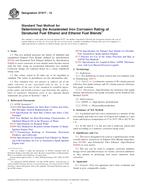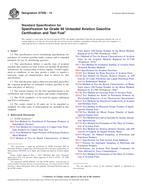Potrebujeme váš súhlas na využitie jednotlivých dát, aby sa vám okrem iného mohli ukazovať informácie týkajúce sa vašich záujmov. Súhlas udelíte kliknutím na tlačidlo „OK“.
ASTM D7844-12
Standard Test Method for Condition Monitoring of Soot in In-Service Lubricants by Trend Analysis using Fourier Transform Infrared (FT-IR) Spectrometry
Automaticky preložený názov:
Štandardná skúšobná metóda pre sledovanie stavu sadzí do ďalšieho mazív analýzy trendov pomocou Fourier Transform Infrared (FT-IR) spektrometria
NORMA vydaná dňa 1.12.2012
Informácie o norme:
Označenie normy: ASTM D7844-12
Poznámka: NEPLATNÁ
Dátum vydania normy: 1.12.2012
Kód tovaru: NS-39180
Počet strán: 4
Približná hmotnosť: 12 g (0.03 libier)
Krajina: Americká technická norma
Kategória: Technické normy ASTM
Kategórie - podobné normy:
Anotácia textu normy ASTM D7844-12 :
Keywords:
condition monitoring, differential trend analysis, direct trend analysis, Fourier transform infrared, FT-IR, hydrocarbon based lubricants, infrared, in-service petroleum lubricants, IR, lubricants, oils, soot, ICS Number Code 75.160.20 (Liquid fuels)
Doplňujúce informácie
| Significance and Use | ||||||||||||||||||||||||
|
5.1 An increase in soot material can lead to increased wear, filter plugging and viscosity, which is usually a consideration for diesel engines, although it may also be an indicator of carburetor or injector problems in other fuel systems. Monitoring of soot is therefore an important parameter in determining overall machinery health and should be considered in conjunction with data from other tests such as atomic emission (AE) and atomic absorption (AA) spectroscopy for wear metal analysis (Test Method D5185), physical property tests (Test Methods D445, D6304 and D2896), and other FT-IR oil analysis methods for oxidation (Test Method D7414), sulfate by-products (Test Method D7415), nitration (Test Method D7624), additive depletion (Test Method D7412), and breakdown products and external contaminants (Practice E2412), which also assess elements of the oil’s condition 1.1 This test method pertains to field-based monitoring soot in diesel crankcase engine oils as well as in other types of engine oils where soot may contaminate the lubricant as a result of a blow-by due to incomplete combustion of in-service fuels. 1.2 This test method uses FT-IR spectroscopy for monitoring of soot build-up in in-service lubricants as a result of normal machinery operation. Soot levels in engine oils rise as soot particles contaminate the oil as a result of exhaust gas recirculation or a blow-by. This test method is designed as a fast, simple spectroscopic check for monitoring of soot in in-service lubricants with the objective of helping diagnose the operational condition of the machine based on measuring the level of soot in the oil. 1.3 Acquisition of FT-IR spectral data for measuring soot in in-service oil and lubricant samples is described in Standard Practice D7418. In this test method, measurement and data interpretation parameters for soot using both direct trend analysis and differential (spectral subtraction) trend analysis are presented. 1.4 This test method is based on trending of spectral changes associated with soot in in-service lubricants. For direct trend analysis, values are recorded directly from absorbance spectra and reported in units of 100*absorbance per 0.1 mm pathlength. For differential trend analysis, values are recorded from the differential spectra (spectrum obtained by subtraction of the spectrum of the reference oil from that of the in-service oil) and reported in units of 100*absorbance per 0.1 mm pathlength (or equivalently absorbance units per centimeter). Warnings or alarm limits can be set on the basis of a fixed maximum value for a single measurement or, alternatively, can be based on a rate of change of the response measured (1).2 In either case, such maintenance action limits should be determined through statistical analysis, history of the same or similar equipment, round robin tests or other methods in conjunction with the correlation of soot levels to equipment performance. 1.5 This test method is primarily
for petroleum/hydrocarbon based lubricants but is also applicable
for ester based oils, including polyol esters or phosphate
esters.
1.6 This method is intended as a field test only, and should be treated as such. Critical applications should use laboratory based methods, such as Thermal Gravimetric (TGA) analysis described in Standard Method D5967, Annex A4. 1.7 This standard does not purport to address all of the safety concerns, if any, associated with its use. It is the responsibility of the user of this standard to establish appropriate safety and health practices and determine the applicability of regulatory limitations prior to use. |
||||||||||||||||||||||||
| 2. Referenced Documents | ||||||||||||||||||||||||
|
Podobné normy:
Historická
1.3.2010
Historická
15.12.2012
Historická
1.1.2012
Historická
1.5.2014
Historická
1.12.2013
Historická
1.5.2013



 ASTM D7576-10
ASTM D7576-10 ASTM D7577-12
ASTM D7577-12 ASTM D7591-12
ASTM D7591-12 ASTM D7592-14
ASTM D7592-14 ASTM D7593-13
ASTM D7593-13 ASTM D7618-13
ASTM D7618-13
 Cookies
Cookies
